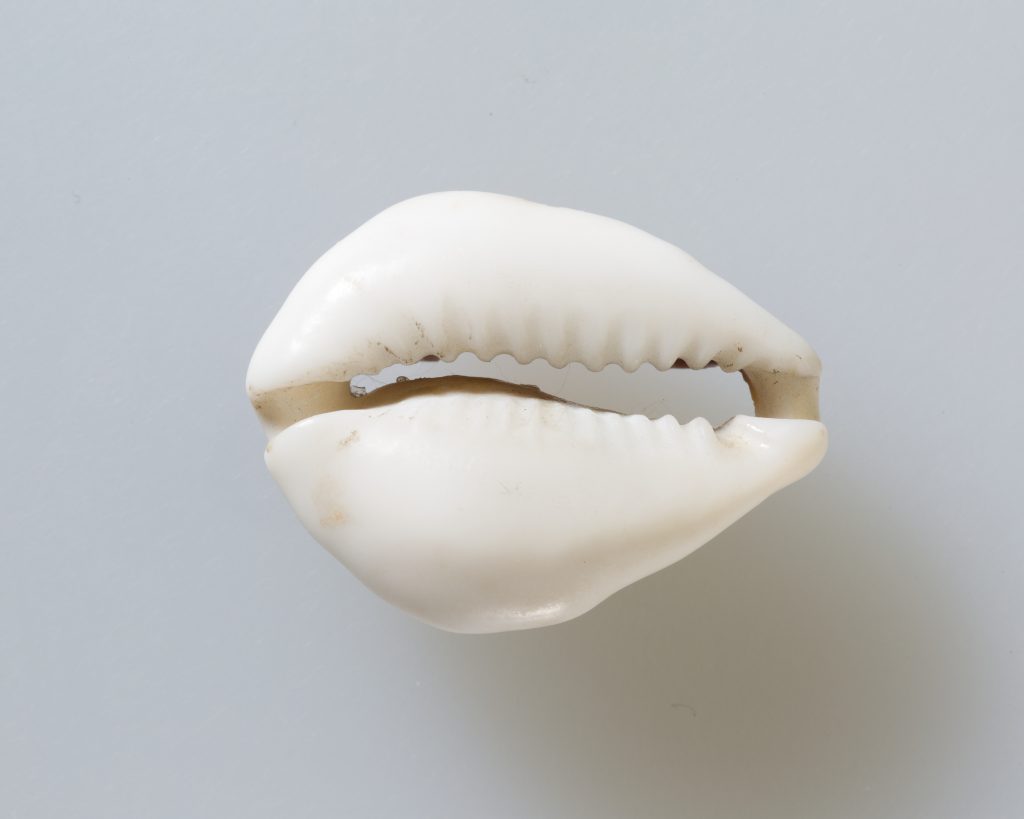Cowrie shells are the shells of small marine snails that are widely distributed in warm seas. Their texture is very smooth due to their glossy finish, and they come in various shapes, patterns, and colors. Although we simply use them for a collection, Cowrie shells had many uses and purpose in ancient times, particularly in ancient Egypt.
In ancient Egypt, women were highly valued for their ability to conceive children. In order to protect their fertility for the future, girls and young women wore Cowrie girdles. They would also be worn during pregnancy in order to protect their child from any harm or complications, and have a safe and successful delivery. It was also believed that women and children in ancient Egypt were often the targets of the so-called evil eye, an evil spirit that would haunt them and was the blame for miscarriages and deaths. The only way to stay protected from the malicious effects of the superstition was by wearing Cowrie shells every day for the rest of their lives. Even when Egyptian women died, they were often buried with a Cowrie shell necklace to protect their spirits in the after life. Cowrie girdles were often adorned by a small naked female that represented the goddess of fertility, and she protected pregnant women throughout their pregnancies. Even though pregnant women were often visited by female birth attendants to make sure that their pregnancy was going well, the Cowrie shells gave them an added sense of protection. After examining the remains of numerous mummies, Egyptian scholars have concluded that Egyptian females must have had fertility difficulties due to their lack of medicine and resources. Those scholars conclude that these women must have depended on their belief in the power of these Cowrie shells. The shape of the Cowrie shell was even thought to symbolize a woman’s pregnancy due to its round shape, seen as similar to a woman’s pregnant belly as the child grows. The vertical opening in the middle of the shell represents the female vulva, which is the main reproductive organ of the woman.1

Gold | Courtesy of the Metropolitan Museum of Art, New York
Cowrie shells in ancient Egypt were also known to be used for decoration purposes. In the tombs of small children, the Cowrie shells were placed around tombs for decoration purposes. There were two very different designs, one for the girls and one for the boys. They were thought to offer a connection between the living and the dead. Cowrie shells were also very valuable, and they were used as jewelry as well, and as home décor. The more Cowrie shells one had, the wealthier one was thought to be, and the more respect one was accorded by the people. Because of their high value, Cowrie shells were commonly used as currency; and they traded the shells for things like food, clothing, and other necessities. In the homes of the Egyptians, there were animal figures that were covered with Cowrie shells. The jewelers who created the decorations and the necklaces used metals to fill the Cowrie shells so that they would make sounds that would capture attention. The jewelers would add gold to the Cowrie shells that would make the shells even more valuable. Such shells were seen as a symbol of the flesh of the gods that were linked to the sun. Silver, another metal added to the shells, represented the bones of the gods and was associated with the moon. The animal that was most used by the ancient Egyptians was the cat. Like the women and children, the Cowrie shells were also used to protect the lives of the animals from evil spirits.2
In conclusion, the ancient Egyptians valued Cowrie shells, and they used for them for many purposes. One of the purposes was their belief that the shells gave some type of protection to women and children from evil spirits. They also protected the lives of the dead when they placed Cowrie shells over their tombs. They also made girdles for pregnant women, who would wear them on their hips in order to protect their wombs and have safe deliveries. When used as necklaces, the Cowrie shells were filled with metals like gold and silver, which gave them significance. We spot them today on the shores of our beaches and don’t realize the importance they have had in the past and the meanings they have carried for lives lived long ago.
- Bill Bynum and Helen Bynum, “Egyptian Cowrie Necklace,” The Lancet Vol. 386, No. 1003 (2016): 1525. ↵
- Amir Goalni, “Cowrie shells and their imitations as ornamental amulets in Egypt and the Near East,” Polish Archaeology in the Mediterranean, Special Studies: Beyond ornamentation 23/2, (2014): 71-94. ↵



53 comments
Johnanthony Hernandez
Interesting article, I knew that the Ancient Egyptians believed that certain naturally occurring items were endowed with the powers of the gods. Such as with the shells, there may have been some relevance to the belief that they protected young girls and women who would become pregnant and while they were pregnant. Much of it probably could have been a psychological factor that shells had. Interesting to think the thought of the shells being a symbol of protection for women and children while also serving to increase a woman’s fertility.
Mario De Leon
This was a fun read. It’s interesting to think how we just collect the shells but ancient Egyptians had many uses and saw these shells as valuable. I find it interesting that in all the Egyptian articles on this website the Egyptian people find a way to make multiple uses out of anything whether it’s a god or these cowrie shells.
Aimee Trevino
Really informative article! I find it so interesting to read about the Egyptians! I would always see these shells back home when we would go out to the island, so it is funny to think how important they were to the Egyptians life. I know that these are also often seen on jewelry nowadays, so it is also interesting to compare how they valued these as a sign of pregnancy and even to an extent fertility. Great read!
Aaron Jaramillo
This is a great article. It was very interesting and informative to read. Looking at your two resources I would guess they were packed with a lot of information. The way you organized your article was helpful when reading. I would always see people sporting these shells but never knew the meaning of it. Great job of this article can’t wait for more!
Ana Gonzalez
Nice article! The superstition about how wearing cowrie shells would protect a woman and her child from the “evil eye” reminds me of a Mexican superstition where being looked at wrong will lead to bad luck! I wonder if this Mexican superstition stems from ancient Egypt!? You did a good job explaining how wearing a cowrie shell provided some comfort and a feeling of protection for woman and children in times when medicine was not as advanced as it is now. Thank you for the interesting read!
Isabelle Salinas
To think something I once thought of as only jewelry and decoration had a much more meaning to the Egyptians is crazy. I usually see these shells in the stores of nearby beaches. Before reading this, I thought they were just another shell. The thought of them being used as currency is most interesting to me. Overall, great job!
Jennifer Pogue
Great article! I have seen jewelry and trinkets at the beach made of what look like cowrie shells, but I thought that was just beach fashion. I really enjoy this article because it is not traditionally taught in the classroom. Today we might think it’s strange how they believed a shell could help them in pregnancy, but we have many strange rituals, wives’ tales, and beliefs about pregnancy and childbirth as well.
Alyssa Valdez
Great Article to read about Ana! I found it very enjoyable and from what you told me at the office and the article that i read, I can tell you put a lot of time and effort into your research! I thought your article was very well put together. I had no idea that shells could be worth so much and have such a significant meaning to people. can’t wait to read your next upcoming article!
Mariana Govea
What an interesting informative article!! I really enjoyed the read! Its super interesting how stuff that to us now a days really has not significance to other people it once met a lot!! Like its really interesting how in Egypt women believed they had to wear these shells in order to be protected throughout their pregnancy as well as to help them maintain fertile which makes perfect sense that they had to believe on something to help them as mentioned int he article that they experienced a lot of miscarriages due to lack of medical supplies therefore believing in something that could help them against that was great!
Marissa Gonzalez
I have always seen these Cowrie shells many times at many places. I had no clue they had so much significance to them. You are correct that people do not realize how much meaning is behind them and what they were used for. However, I did find it unusual that jewelers added gold and metals to these shells to add more value. I always saw these shells as being accessories such as jewelry. However, it is interesting how they were used to protect others from the “evil eye” by wearing them every day for the rest of their lives. I loved your article because it was very interesting and I learned a lot. Great job!